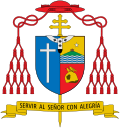| Cerro de Montevideo | |
|---|---|
 View of the Bay and Hill of Montevideo at dusk, ca. 2011. | |
| Highest point | |
| Elevation | 132 m (433 ft) |
| Coordinates | 34°53′18″S56°15′36″W / 34.88833°S 56.26000°W |
| Naming | |
| English translation | Cerro (Hill in Spanish); Montevideo has a disputed origin [1] |
| Language of name | Spanish |
| Geography | |
| Location | Montevideo Department, Uruguay |
| Parent range | none |
| Geology | |
| Mountain type | Hill |
| Climbing | |
| Easiest route | Automobile |
Cerro de Montevideo is a hill overlooking the namesake capital city of Uruguay. It constitutes an isolated landform, it is part of no mountain range.
Contents
Its notable fortress on top overlooks the Bay of Montevideo, a natural harbour on the coast of the River Plate. [2] Its lighthouse is of tantamount importance for navigation.







